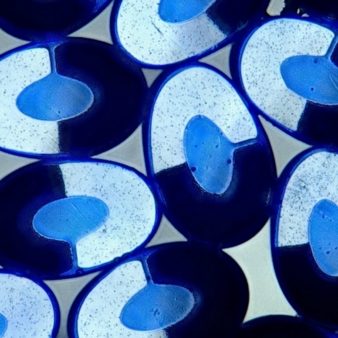07/04/2021 – Nanodesign by Toray — auf Deutsch lesen
Camifu: A textile inspired by Japanese paper
A newly developed fabric from materials technology company Toray combines the feel and texture of handmade Japanese paper with modern functionality.
The novel polyester filament fabric is based on the patented multi-component spinning process Nanodesign, which allows Toray to precisely arrange and shape different polymers within one fiber. The resulting structure, with its subtle unevenness, mimics that of handmade paper, but at the same time brings the softness and comfort of synthetic fibers.
Using the Nanodesign process, Toray developed a fiber with a flat, C-shaped cross-sectional structure that combines three different polymers.
In the center of the fiber is a soluble polymer, to the right and left of which are polymers with different heat-shrinkage properties.
One of the polymers was made from recycled film scraps to make Camifu more sustainable.
When these adjacent polymers are heat treated, they bend along the fiber according to their respective thermal properties. Combined with the flat cross-section, this creates a unique twist and stretch. The individual fibers are deliberately placed next to each other in such a way that they vary in shape and torsional structure. This creates fiber bundles with irregular cavities, which provide the characteristic unevenness of the material. This effect is reinforced by the additional hollow space inside the fiber created by the soluble polymer. A precisely placed slit in the fiber allows Toray’s engineers to permanently incorporate a range of features, such as antibacterial properties, directly into the fabric.
The high proportion of hollow spaces gives the fabric a light yet robust feel that corresponds to the feel of handmade Japanese paper. Visually, Camifu also follows this model: the fibers contain differently colored or dyeable polymers that do not align with each other. This creates fluctuating color variations that are typical of Japanese paper.
These characteristics make Camifu ideal for applications in men's and women's outerwear, including shirts, blouses, cut and sewn garments. The company plans to launch Camifu from spring/summer 2022. Toray is confident of selling around 500,000 meters of the material by 2025.
“It will become increasingly important in the future to combine advanced functionality, comfort and sustainability,” the company says. With its innovative technologies and advanced materials, Toray aims to contribute to a better and more sustainable future.
Toray Industries, Inc. is a leading global manufacturer of high-performance materials headquartered in Tokyo. The company was founded in 1926 and has been under the leadership of Akihiro Nikkaku since 2010. Toray employs approximately 48,000 people in 29 countries worldwide (as of 2020). The company’s product range includes the manufacture and processing of textiles and fibers, as well as plastics and a wide range of performance chemicals. Toray Industries is also the world’s largest manufacturer of PAN-based carbon fibers. In Europe, the group is represented by Toray Industries Europe GmbH, based in Neu-Isenburg.




